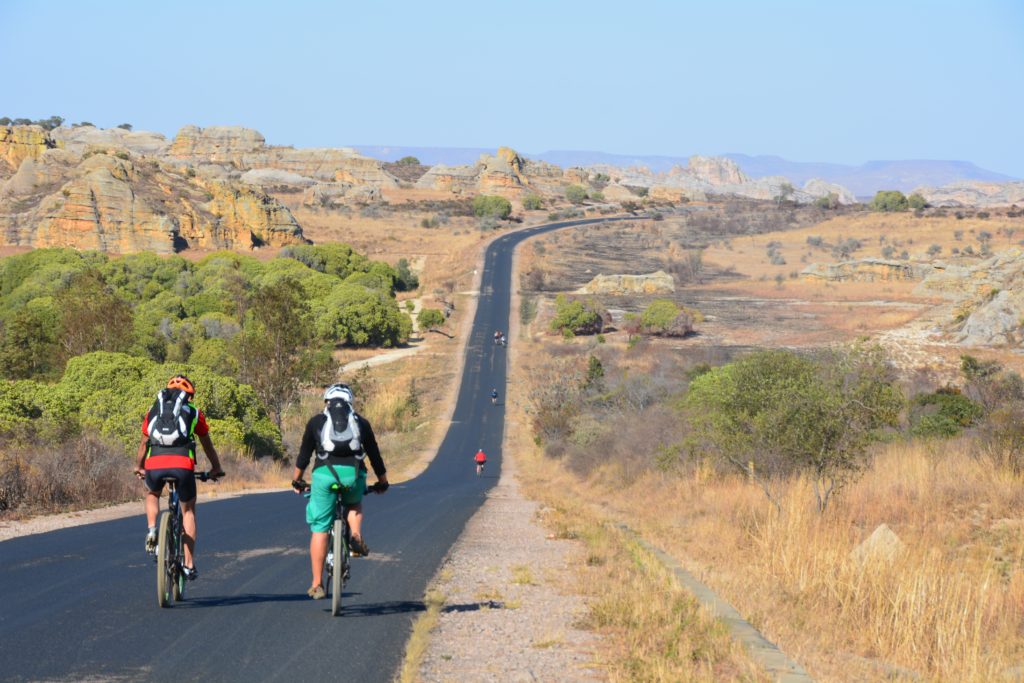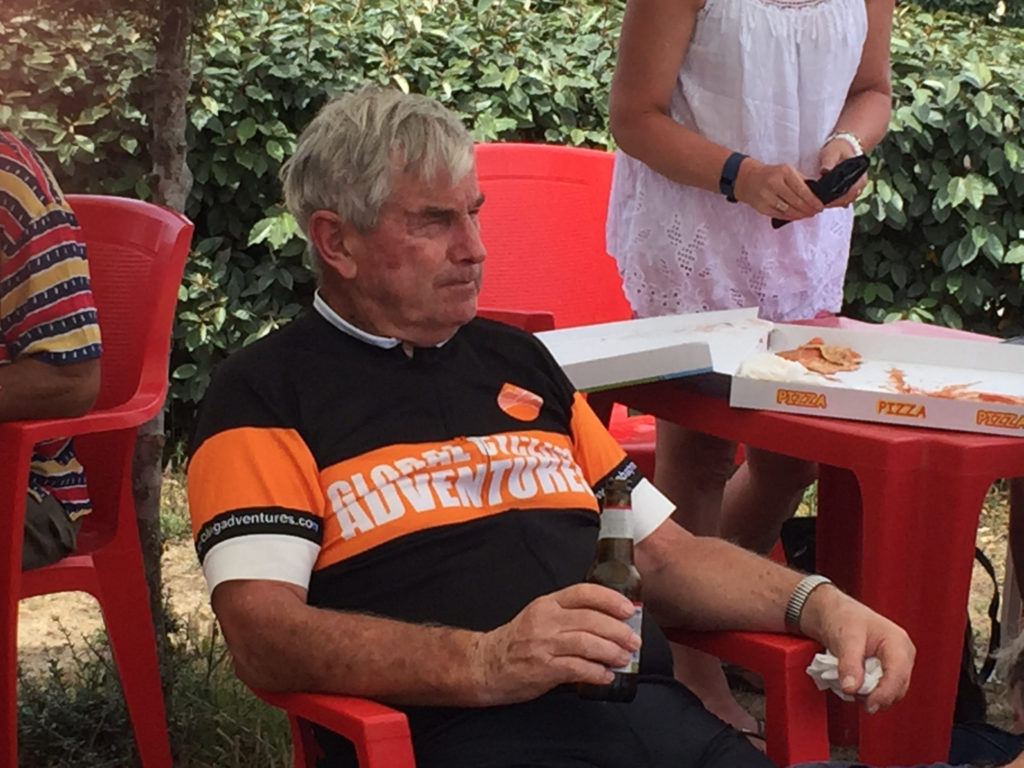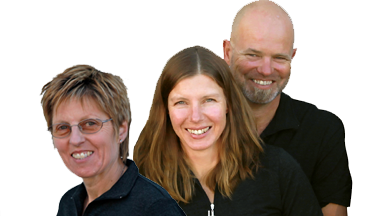Graeme Oakley, 76-year-old West Melton spud farmer and bike traveller.
WORDS AND IMAGES ROY SINCLAIR
When I meet Graeme, he is about to pack for his next adventure, heading to Norway to cycle 900 km, then Iceland for another 800 km. He will be in a group organised by Global Cycling Adventures, with its headquarters in Governors Bay.
His front room displays books from previous tours he has joined. They include France, Argentina, Sardinia Corsica, Vietnam, Madagascar and the Camino in Spain.
His present trip is his ninth with Global Cycling Adventures, operated by Ralph and Simone Freeman. “Being a German Ralph plans each trip to the finest detail.” said Graeme. He confesses to having been the grump of the group. His non-smiling countenance when I take his photograph it fails to hide his sense of humour which his accompanying travellers make the most of.
They photograph him digging a few spuds whenever Graeme sees them on his travels. He was surprised to find some good ones in Madagascar.

Cycling in Madagascar.
Graeme grew up in Hororata where biking, frosty or rain, was the only way to get to school. Later, at Darfied High School, he met Dorothy. They had both just turned 14. Dorothy and Graeme married in 1962. “She was my friend for 55 years, prior to her dying of metastatic cancer in January 2011.”
Dorothy was the cyclist. She would sit up all night watching the Tour de France. She cycled an astonishing number of kilometres. And at the same time kept up with community work.”
I spot several certificates on display acknowledging Dorothy Oakley’s community achievements.
The couple moved to the West Melton potato farm in 1963. It had been purchased by Graeme’s grandparents around 1873. A huge oak tree began as an acorn Graeme’s grandfather picked up at Halkett School.
The small farm was not particularly successful. Diseased sand soil and droughts contributed to lean times. Graeme’s father acquired land near Southbridge. Graeme’s son, Robin, has a thriving vegetable-growing business in Southbridge.
Graeme chats about leaving school a month after he turned 15. “I thought I would rather grow potatoes than spend time learning algebra and trigonometry. That was a mistake. I should have stayed another year. Algebra would have been very, very handy for me. Fortunately, I had taken in geometry, understanding characters of different shapes.”
Dorothy talked him into getting a couple of bikes. They travelled extensively. One trip involved bicycle and rail travel in Italy. Graeme organised a family ride of the Otago Central Rail Trail.
“When my son Robin was full of enthusiasm having done a couple of trips with Ralph Freeman I ended up really getting the cycling bug.”
The timing was fortuitous for Graeme. He was getting over losing Dorothy. He offered to join a North Island trip Robin was going on. “I could be on the bus and help with tea breaks and setting up lunch. Ralph rang me and said I sounded like a reasonable sort of rooster, so I was on. I ended up driving the support vehicle. Ten days of looking at cyclists backsides are not everyone’s cup of tea but I enjoyed it so asked Ralph if I could join his upcoming trip to Vietnam. The group was riding mountain bikes and doing no more than about 60 km a day. I went on that. I had already booked to be a bus passenger for Ralph’s 2014 trip to France. “Global Cycling Adventures were dubbing it ‘the Tour de France,’ covering 3600 km over six weeks. Robin had booked as a cyclist.
On the second day in Vietnam Ralph tells me I’m not going to be sitting on my bum on a bus in France. I will be riding a bike. “I said, ‘yes, pigs might fly.'”
Ralph said, ‘have you heard of an e-bike?'”
“I said we would have a chat some time. That’s how I started.”
With Ralph’s help, Graeme got a Trek e-bike. He did about 1200 km around home, including a few climbs of Porters Pass to get the hang of it.
In France, Ralph arranged for a new Trek e-bike from Germany.
“I hoped it wouldn’t arrive on time and I could leave it packed up and sit on the bus. It didn’t happen that way. I got to ride in every day except for the when we went over Col d’Allos (2250 m). We had a late lunch at about two o’clock. Cloud, black as pitch, came almost down on us. Thunder was rolling around. I had plenty experience tramping in mountains around home. No way was I going to go up through there. I really expected Ralph to announce that it was off. But away they went. Son Robin went. He was kitted out with all the gear. They were like drowned rats by the time they got to the top. They had no idea what they were riding into. Two had initial signs of hypothermia. Just over the top was a small hut. Robin got the two in there, and they hugged till some warmth got into them. By that time the support vehicle arrived, picked them up and got them to where they were staying. It was, I thought, a big risk. I’ve seen people with hypothermia. You really can’t play with it.”
It was the only half-day Graeme did not ride. He celebrated his 73rd birthday two days after the tour finished in Paris.
“A lot of people told Ralph he was crazy doing six weeks in France. Riders will get tired, grumpy and all sorts of things. It never happened. The trip was sweet as a nut. I never heard a cross word the entire time.”
Graeme rode the 3600 km, climbing over 44,000 vertical metres. (138,000ft.)
A highlight was Col de la Madeleine (1993m) described as beautiful but heartbreaking – 26 km and average grade 6.2 percent. It’s one of the hardest climbs in the French Alps. Graeme says “no one wanted to leave the summit once we got there.”
Robin Oakley rode it all on a road bike. He did some extra riding to make it 4000 km. Graeme recalls that some took it as if riding the real Tour de France. “Robin started that way then said, ‘this is nuts’.” He then rode as a free agent exploring villages and their vegetable markets.
A second group was slower and were a little more relaxed. A third group I was in with Ralph actually saw France and took a few photographs. We arrived at end of day about an hour and a quarter after the faster ones.
“One of the speedsters over did it and ended up not riding for three of four days.”
Graeme was awarded the Spotted Jersey (King of the Mountain) for his climb of Ventoux. The Yellow Jersey is given for something notable. Graeme got it for riding 127 km on his second day. It is all part of the entertainment of Ralph Freeman’s trips.
Graeme says Ralph also knew of intriguing places which most people would miss. Accommodation was more than adequate as was the food. “We had thorough briefings each evening. While riding we had a guide with each group. We were well looked after.”
The final day in France was amazing. Graeme and Robin were riding together. “We rode 120 km. A lot of it was along a canal. About 10 km from the finish we could see a thunderstorm brewing. We found shelter then continued. About one kilometer from the finish a hail storm hit. Then one almighty crash of thunder. And the sun came out.”
“How’s that for a finish?”
It was celebrated with a beer, captured in a photo Graeme titled, Dad and Lad.

Graeme relaxing in Sardinia.
An Argentinean trip also provided many tough climbs in the Andes. “In the Salta region we were up at 4000 metres but rode only a short distance at that altitude than goodness.”
The group mostly rode mountain bikes. “The first day had us going 21 km uphill on unsealed roads. I got to 15 km before I felt I had just about done too much. My breaths got closer and closer together till I thought it was crazy. About three of the sixteen in the group made it to the top at about 3400m. One guy who made it wasn’t up to an evening meal. He had really blown himself out. It was another 20 km on sealed roads to where we were staying for the night. After a good lunch that 20 km was okay.
Madagascar (in 2015) was an eye-opener. It was mostly rural. Graeme says the people were lovely. Fifty per cent of their population is aged under 15.
“School holidays made for a curious time. I’ve never seen so many small, dark-skinned people running around. Sometimes I would think I was in Asia. It is contoured like an Asian country. Sometimes Australia because of the reds. Madagascar is known as the red island. They don’t have a lot of water but they are very clever in how they use it.”
Lunch breaks would have them presented with an amazing buffet of vegetables. Potatoes, carrots, three different types of onion, green beans and artichokes. Vegetables made up for Madagascar not having much meat.
Graeme’s companions were from a variety of countries. Many of the same people pop up on different trips. Mishaps when cycling have been rare.
At the end of a trip everyone submits their photographs. Ralph selects images for a book of highlights. He designs it himself on his PC then has hardback copies printed. Graeme calculates he has pedaled in excess of 10,000 km on Ralph Freeman’s trips.
I don’t ride with clip pedals. I wear sandals and get a lot of flak. But I don’t have smelly feet. They get plenty of ventilation.” At 76 he says he would like to keep bicycle travel up a bit longer. “I’ve put my name down for a 40-day trip next year from Prague to Istanbul.”
Some training is essential. General fitness will see him through. It is his backside that needs toughening up. “I have no wish to be surgically separated from my bicycle saddle,” he laughs.

Graeme on his e-bike in Iceland.
E-bike or total pedal power?
Graeme Oakley says he would not be doing his cycling journeys if he did not have an e-bike. But there are pluses and minuses – as he found out in France.
A road bike weights in a 7 or 8 kg. An e-bike is three times that. And it cuts out about 25 km/h. On a flat road with no headwind roadies are doing 30 km/hr or more.
“With no power on a heavier bike you’re hanging out.It’s hard work to keep up. Going downhill is another negative. An e-bike doesn’t have the range of gears. I cannot catch up with the pedals going downhill. On a steep downhill I have the advantage because of my 90 kg body weight and a heavier bike. On a gentler downhill I’ve been out to 45 km/h and still pedaling. That’s my lot. They will be doing 60 km/hr. Uphill is different With the first increment of power I’m about equal to them. With the third or fourth increment I’ve got a big advantage to enable me to be doing what I am doing.”
He carries a spare battery. His quickest use of a battery was on a long (32 km) steep climb.
Over the last three kilometres of Mount Ventoux Graeme was climbing, pedaling hard, at about 22 km/hr. The road bikes were down to 3 or 4 km/hr.
He would expect to get 70 or 80 km from one battery charge.
“I still need to pedal. It is just that much easier. I lost 7 kg in France.”

Graeme (right) with Ralph Freeman on tour in Norway 2018.

